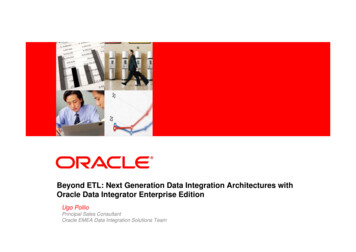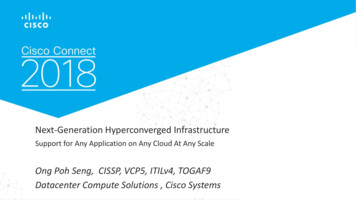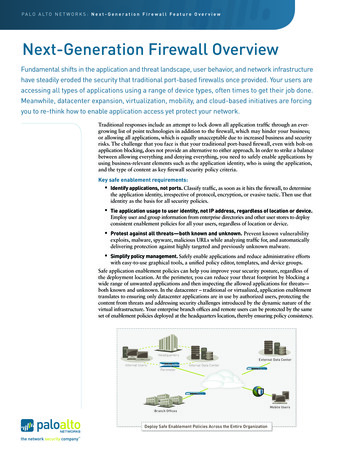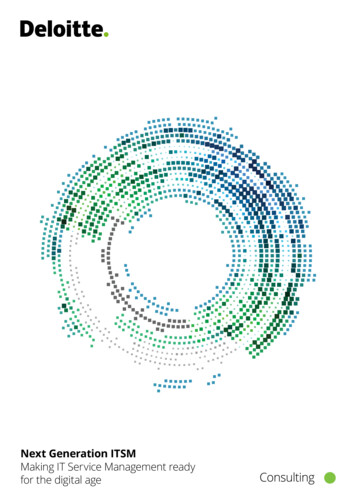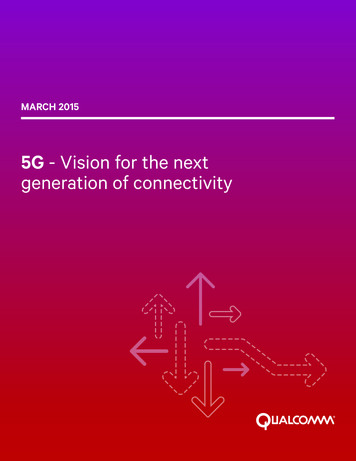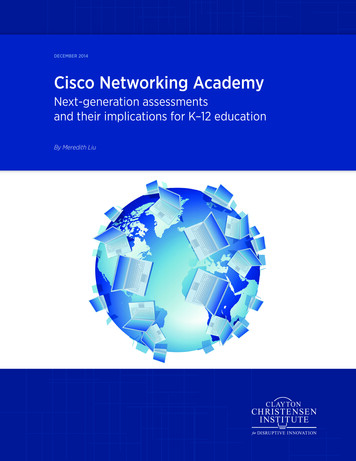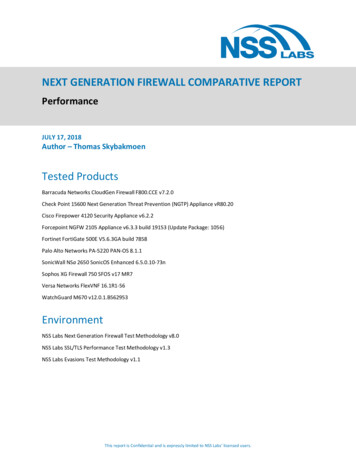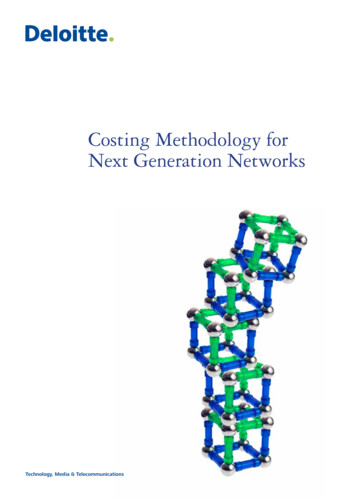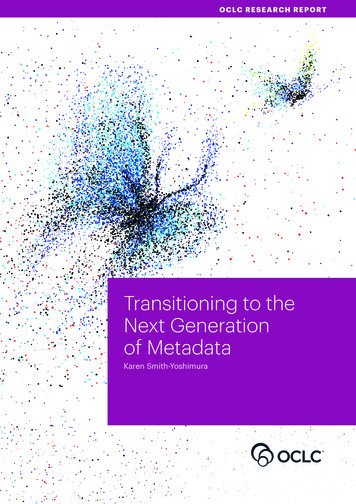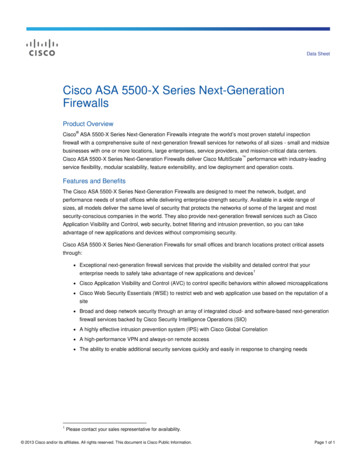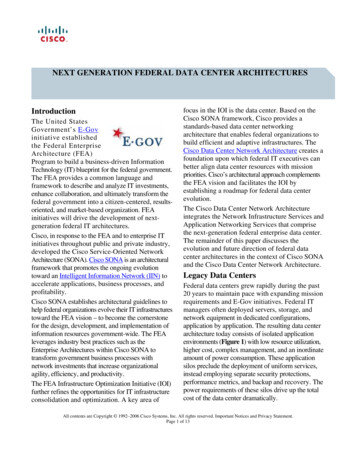
Transcription
NEXT GENERATION FEDERAL DATA CENTER ARCHITECTURESIntroductionThe United StatesGovernment’s E-Govinitiative establishedthe Federal EnterpriseArchitecture (FEA)Program to build a business-driven InformationTechnology (IT) blueprint for the federal government.The FEA provides a common language andframework to describe and analyze IT investments,enhance collaboration, and ultimately transform thefederal government into a citizen-centered, resultsoriented, and market-based organization. FEAinitiatives will drive the development of nextgeneration federal IT architectures.Cisco, in response to the FEA and to enterprise ITinitiatives throughout public and private industry,developed the Cisco Service-Oriented NetworkArchitecture (SONA). Cisco SONA is an architecturalframework that promotes the ongoing evolutiontoward an Intelligent Information Network (IIN) toaccelerate applications, business processes, andprofitability.Cisco SONA establishes architectural guidelines tohelp federal organizations evolve their IT infrastructurestoward the FEA vision – to become the cornerstonefor the design, development, and implementation ofinformation resources government-wide. The FEAleverages industry best practices such as theEnterprise Architectures within Cisco SONA totransform government business processes withnetwork investments that increase organizationalagility, efficiency, and productivity.The FEA Infrastructure Optimization Initiative (IOI)further refines the opportunities for IT infrastructureconsolidation and optimization. A key area offocus in the IOI is the data center. Based on theCisco SONA framework, Cisco provides astandards-based data center networkingarchitecture that enables federal organizations tobuild efficient and adaptive infrastructures. TheCisco Data Center Network Architecture creates afoundation upon which federal IT executives canbetter align data center resources with missionpriorities. Cisco’s architectural approach complementsthe FEA vision and facilitates the IOI byestablishing a roadmap for federal data centerevolution.The Cisco Data Center Network Architectureintegrates the Network Infrastructure Services andApplication Networking Services that comprisethe next-generation federal enterprise data center.The remainder of this paper discusses theevolution and future direction of federal datacenter architectures in the context of Cisco SONAand the Cisco Data Center Network Architecture.Legacy Data CentersFederal data centers grew rapidly during the past20 years to maintain pace with expanding missionrequirements and E-Gov initiatives. Federal ITmanagers often deployed servers, storage, andnetwork equipment in dedicated configurations,application by application. The resulting data centerarchitecture today consists of isolated applicationenvironments (Figure 1) with low resource utilization,higher cost, complex management, and an inordinateamount of power consumption. These applicationsilos preclude the deployment of uniform services,instead employing separate security protections,performance metrics, and backup and recovery. Thepower requirements of these silos drive up the totalcost of the data center dramatically.All contents are Copyright 1992–2006 Cisco Systems, Inc. All rights reserved. Important Notices and Privacy Statement.Page 1 of 13
Figure 1. Legacy Data Centers with Application SilosThe growth of applications and data continues toaccelerate due to ongoing mission requirementsin homeland security and national defense, aswell as regulations on information securityand privacy such as the Healthcare InsurancePortability and Accountability Act (HIPAA) andthe Federal Information Security ManagementAct (FISMA). Mission requirements andregulations are driving federal IT managers toview their information networks holisticallyand evolve their infrastructures within a new,standards-based design framework. Moreover,federal CIOs recognize the operational costsavings they can achieve by investing in systemsand networks that streamline application andservices deployment and reign in data centerpower consumption.To meet these objectives, dedicated applicationsilos in the data center must yield to consolidatedinfrastructures with virtualized services. Theability to leverage uniform services increasesthe flexibility and simplicity of infrastructureand application management across the entiredata center.A New Data Center ModelThe Cisco SONA framework outlines howfederal enterprises can evolve to an IntelligentInformation Network that optimizes applications,business processes, and resources. Cisco SONAis based on the principle that by making the rightinvestment in the network, federal CIOs candramatically increase productivity and efficiencywhile improving business resilience, reducingcosts, and aligning with mission priorities.The Cisco Data Center Network Architecture,based on Cisco SONA, provides a system-levelframework to address immediate data centerdemands for consolidation and businesscontinuance. Cisco combines NetworkInfrastructure Services and Application NetworkingServices to enable emerging Service-OrientedArchitectures (SOAs), virtualization, and ondemand computing technologies. Cisco’sarchitecture approach presents federal ITdecision makers with greater freedom to deploystorage, compute, and software technologies thatbest support their mission needs.All contents are Copyright 1992–2006 Cisco Systems, Inc. All rights reserved. Important Notices and Privacy Statement.Page 2 of 13
The Next-Generation Federal Data CenterArchitecture can be viewed in three layers:network, compute, and storage (Figure 2). Eachlayer performs a distinct role within the CiscoData Center Network Architecture, linkinginteractive services to applications and criticalbusiness process flows.Figure 2. Three-Layer Data Center Modelinterconnects to run parallel applications at aThe network layer provides secure and reliablefraction of the cost of traditional supercomputers.access to the compute layer. It uses Layer2/Layer 3 network switches (e.g., Ethernet andThe storage layer stores the data used byIP) to connect users with data center resources.applications on storage subsystems (e.g., diskAppliances and service modules ensure securedrives and tape drives). The storage layer usesaccess and optimize resource utilization andstorage switches and optical transport platformsperformance.to interconnect and provide access to diskresources within and between data centers.The compute layer provides the computingresources (i.e., servers and mainframes) that runConsolidation and End-to-Endapplications invoked by users. Server switchesVirtualizationinterconnect the computing resources andprovide access to the storage layer. TraditionallyApplication silos cannot effectively scale to meetin the compute layer, parallel applications havethe expanding demands on today’s data centers.run on supercomputers that are prohibitivelyNext-generation data centers consolidate theexpensive for many companies to acquire andinfrastructure and virtualize resources across aoperate. High-Performance Computing (HPC)smaller number of components and facilities –clusters today use the same principles assaving precious kilowatt-hours. Data centertraditional supercomputers. HPC clusters areresources are no longer dedicated to specificmade of multiple (sometimes many thousands)applications but are logically assigned toindustry-standard computers that use clusterapplications as needed (Figure 3).software and high-performance networkAll contents are Copyright 1992–2006 Cisco Systems, Inc. All rights reserved. Important Notices and Privacy Statement.Page 3 of 13
Figure 3. Next-Generation Data Centers – Consolidation and Virtualizationarchitecture. Figure 4 illustrates a legacy dataThis approach simplifies management, expeditescenter with dedicated resources at each layer.the deployment of new applications, optimizesUsers within a department or workgroup connectresource use, and reduces operating costs. Ato a Local Area Network (LAN) dedicated to thevirtualized infrastructure simplifies theworkgroup. Applications which are specific todeployment of intelligent services and allowsthe workgroup run on dedicated servers andfederal CIOs to thoughtfully invest in anstorage. Each workgroup contains dedicatedintelligent information network that delivershubs, servers, and storage subsystems. At thecritical support services for their ongoingnetwork layer, routers interconnect workgroupsmission requirements.but backend storage and compute resourcesThere are many aspects to virtualizationremain dedicated. Without virtualization, theacross each layer of the data centerresulting application silos form by default.Figure 4. Data Center Architecture with Dedicated ResourcesAll contents are Copyright 1992–2006 Cisco Systems, Inc. All rights reserved. Important Notices and Privacy Statement.Page 4 of 13
Network Layer Consolidation andVirtualizationNetwork layer consolidation interconnectsnetworking resources into a shared, intelligentnetwork. Virtualization permits the dynamicassignment of networking resources to usersand applications with services such asDynamic Host Configuration Protocol(DHCP) and Network Access Control (NAC).Figure 5 illustrates a data center with avirtualized network layer. Virtualization atthis layer begins to break down applicationsilos by opening access to applications acrossa switched LAN.Network switches supporting Virtual LAN(VLAN) technology, most commonly overEthernet, enable virtualization at the networklayer. With VLANs, network resources arepooled and logically assigned to users andapplications as needed. This architecturerepresents the state of most data centers today.A virtualized network layer eliminates theneed to purchase dedicated LAN hubs orswitches for new applications by providingubiquitous access to the applicationenvironment over the network infrastructure.Figure 5. Data Center Architecture with Virtualized Network Layerfurther breaks down application silos byStorage Layer Consolidation andinterconnecting storage resources via a singleVirtualizationintelligent SAN. By virtualizing the storageThe next step in an end-to-end virtualized datalayer, storage can be treated as a pooledcenter is the consolidation and virtualizationresource and dynamically assigned toof the storage layer. Applications today areapplications as required.often deployed with dedicated storageStorage switches that support VSANsubsystems interconnected by a single Storagetechnology enable storage layer virtualization.Area Network (SAN) island. StorageVSANs allow administrators to pool disks andconsolidation combines SAN islands andstorage arrays on a common infrastructure andAll contents are Copyright 1992–2006 Cisco Systems, Inc. All rights reserved. Important Notices and Privacy Statement.Page 5 of 13
logically distribute storage among applications(Figure 6). A virtualized storage layer doesnot require the purchase of dedicated storageor SAN switches for new applications.VSANs segregate fabric services amonglogical groups to decrease the fault domainand minimize fabric disruptions duringplanned and unplanned outages on the SAN.Administrators can then consistently managethese separate virtual fabrics and applycomprehensive security policies across theentire consolidated storage infrastructure.As with a virtualized network layer,virtualized storage promotes efficient resourceusage, reduces costs, and expedites thedeployment of new applications.Virtualization also simplifies management bycombining dedicated SAN islands onto acommon SAN. Today’s SAN switchingtechnology provides multiprotocol supportand optical transports that allow federal ITmanagers to address disaster recovery andContinuity of Operations (COOP) policies andregulations by extending the SAN across theWAN.Compute Layer Consolidation andVirtualizationThe final element of end-to-end data centerconsolidation and virtualization resides at thecompute layer. Compute consolidationconnects server resources via an intelligentCompute or Cluster Area Network (CAN).Server resources are assigned to VirtualServer Groups (VSGs) and dynamicallyreassigned as needed (Figure 7). Based on theassigned VSG, diskless servers remotely bootthe appropriate Operating System (OS) andexecute applications as assigned by theadministrator. Compute consolidation reducescosts and increases efficiency by allowing theuse of standard servers in pooledconfigurations. Combined with a virtualizedstorage layer, compute layer virtualizationsignificantly decreases the time it takes tobring up new applications and services.Figure 6. Data Center Architecture with Virtualized Network and Storage LayersAll contents are Copyright 1992–2006 Cisco Systems, Inc. All rights reserved. Important Notices and Privacy Statement.Page 6 of 13
Figure 7. End-to-End Virtualized Data Center ArchitectureEnd-to-End Intelligent ServicesThe growth of application silos in legacy datacenters is challenging for the deployment ofintelligent services. Each silo requires separatesecurity, optimization, backup, and disasterrecovery planning, which increasescomplexity and cost and complicates systemmanagement across the data center. Aconsolidated data center with pooled resourcesstreamlines the deployment of intelligentservices. Like other data center resources, theintelligent services are shared and dynamicallyassigned where needed.Intelligent data center services include anabundance of features that impact availability,resource optimization, security, andperformance. The effective deployment ofintelligent services requires an end-to-enddesign where the requisite services are appliedat each layer of the data center architecture(Figure 8).All contents are Copyright 1992–2006 Cisco Systems, Inc. All rights reserved. Important Notices and Privacy Statement.Page 7 of 13
Figure 8. Next-Generation Data Center – Uniformly Deployed Intelligent ServicesNetwork Layer I
Cisco Data Center Network Architecture creates a foundation upon which federal IT executives can better align data center resources with mission priorities. Cisco’s architectural approach complements the FEA vision and facilitates the IOI by establishing a roadmap for federal data center evolution. The Cisco Data Center Network Architecture
